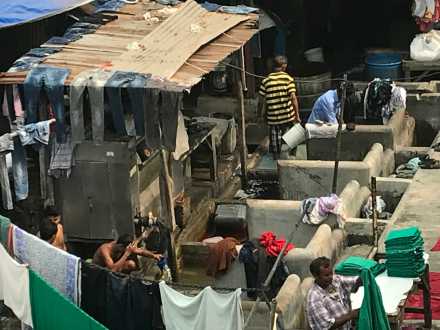Dhobi Ghat
We decided to walk to Dhobi Ghat, next to Mahalaxmi railway station. This is a laundry, built by the British Raj in 1890, and still in use today. It was easy to find, as it really is right next to the station, and you can see lines of washing as you approach. We stood on the bridge, next to the station, and looked down at the laundry.
There were concrete pools of water, each with a flogging stone (where the laundry is bashed until clean). People stood in the pools, dunking linen, and rinsing it in great vats of water. There were also people washing themselves and cleaning their teeth – it all seemed to happen in the same water, though I could see a narrow gulley that was taking away the dirty water. Hanging above them, were lines and lines of washing.
The laundry is used by hotels and hospitals, and smaller laundries, who send the linen there to be washed, and then iron it before returning it to the customer (for a profit). Clothing manufacturers also send stuff there that they want ‘stone washed’, and we saw lots of jeans hanging to dry. They also dye fabric. The owner’s name is written in the back of garments, so they all get returned to the correct people (though it looked to me as if there might be muddles sometimes).
 The people who work there are called ‘dhobis’. They don’t earn much, and many now also double up as tour guides. Some have installed washing machines and dryers, which we could see under awnings, but there was still lots of hand-washing happening.
The people who work there are called ‘dhobis’. They don’t earn much, and many now also double up as tour guides. Some have installed washing machines and dryers, which we could see under awnings, but there was still lots of hand-washing happening.
The laundry is big – I read that 7,000 people work there. There were little pens, and tiny houses, all within the laundry walls, though some people live in the slums outside. Lots of tourists were there, taking photographs. We could see lots from the bridge, though for once I wished I had my big camera and not just a phone to take photos.
We walked down, looking for a way inside. The street was very crowded, with tiny shops and stalls and traffic and people. We passed a stall selling meat – there were chickens wilting in the sunshine behind the stall, struggling to get next to a fan. They were killed to order, which makes for very fresh meat (which is necessary when there’s not refrigeration) but an unhappy life for a chicken. We also passed blocks of public washrooms, when you tried to not breath in as you walked past. They are probably the only facilities available for the people who live there, as there didn’t look like they had any plumbing actually in their houses.
We found a gate into the laundry. There was a faded sign, saying that it was in The Guinness Book of World Records, for the most hand-washing done at once. A man appeared, and offered to give us a tour. But it all looked a bit daunting and ‘unofficial’, so we declined.
It was very interesting. When we got back to the hotel, I read that the local people don’t particularly like the laundry, seeing as a dirty place. Apparently most of the cases of malaria and dengue fever come from the laundry. The slums surrounding the laundry are gradually being cleared away, and replaced with tower blocks for the workers to live in. I hope they are better.
***
I hope you’re enjoying my blogs about India. I have visited several times over the last few months, mainly going into the poorer areas and talking to people, learning about their lives, so I could write my next book.
CLARA – A Good Psychopath?
Due to be released soon. Don’t miss it. A compelling read with some huge ideas.
Thank you for reading.
Why not sign up to follow my blog?
anneethompson.com
xxxxxxx






Incredibly interesting!
LikeLiked by 1 person
Yes, it was an amazing place. Not your usual tourist attraction!
LikeLike